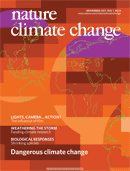Nature Climate Change Volume 1 Issue 8
Nature Climate Change, November 2011

The amazing giant saguaro cactus of Arizona’s Sonoran Desert in the southwestern United States does what its human neighbours cannot. It survives
on 8 to 15 inches of annual rainfall. The Saguaro sucks up these rare drenchings through extra-long shallow roots, holding the water deep inside its leathery, crevassed skin. A tree-sized saguaro can live for a few hundred years, and it grows very slowly, pushing spiny arms towards the blistering sky. Walking through the Sonoran Desert, an unadapted human is soon humbled by the interplay of resilient plants and animals that have learnt to thrive on almost no water. Successful desert animals know how to tunnel inside the spiky Saguaro and other thorny water-storing cacti for food and shelter. These creatures instinctively avoid the heat of the day and do their work in the dark and coolness.
In this landscape, millions of people do survive, but in a manner better suited to space travellers on alien planets. They import what the environment cannot provide: water. They pipe it from the strained Colorado River under the terms of a multistate compact passed in 1922 between Arizona, California, Colorado, Nevada, New Mexico, Utah and Wyoming.
Now, the results of a two-decadelong drought threaten the future of the American Southwest. The average nighttime temperature in sections of Phoenix in Arizona have risen by more than 6°C over the past 50 years. Stored water levels are dangerously low in Lake Mead, which holds the Colorado River’s water above the Hoover Dam at the shared border of Arizona, Nevada and California; and at Lake Powell, which holds the river above the Glen Canyon Dam on the Utah–Arizona border. The Southwest depends on this water. It cools electric power plants, irrigates farms, lawns and golf courses. It fills cooking pots, toilets, showers, hot tubs and swimming pools. Climate change models predict worse for the Southwest, particularly in southwestern Arizona.
Two new books sketch the disaster that has been unfolding in the American Southwest since the mid-1990s. In A Great Aridness: Climate Change and the Future of the American Southwest, New Mexico resident William deBuys describes trips he made around Arizona, New Mexico, Nevada, Utah and Colorado. DeBuys, a conservationist who has written several environmental books, talked to scientists, politicians and activists for this latest book,
which he calls “a love story, of sorts” about the region where he has lived since 1972. It’s a region that scientists say will suffer continued drought and rising temperatures under climate change.
The Southwest “promises to be centre stage for the continent’s drama of climate change,” deBuys writes, because scientists predict the region’s climate will change faster than other places. “Already data from the field suggest that the models are correct —except in one important respect: the changes are occurring faster than expected.” Nevertheless, he adds, over the past few decades, the Southwest grew faster than any other American region, and is ready to resume growing after the recession.
“And if the effective yield of water declines, whether because of higher temperatures or less precipitation, or a likely combination of the two,” he adds, “Southwesterners and their oasisbased, aridland, hydraulic society will have to reinvent themselves in new and, undoubtedly, painful ways.”
New York University’s social and cultural analysis professor Andrew Ross’s new book makes much the same argument, but his focus narrows on the city of Phoenix in Arizona. In Bird on Fire: Lessons from the World’s Least Sustainable City, Ross draws on interviews with 200 Phoenix citizens for this digest of political denial. Phoenix leaders talk a little about curbing growth and water use, but they assume that the fast growth and construction — slowed by the current recession — will pick up again. Phoenix intrigued Ross, because unlike many other Western cities it has failed to take true steps towards sustainability. Political battles there and at the federal level have shaken the solar photovoltaic industry, public transportation and limits on building. The city’s majority Democrats, he writes, wanted to reduce the city’s carbon emissions, but the state’s majority Republican government, which gives no money for transportation, restricted them. Limits on property taxes that could fund city programmes slowed the city’s light rail project, and the city manager told Ross that Phoenix is now “where New York City was in the 1880s”.
All of this suggests that the Southwest ignores, or thumbs its nose at, the evidence for a drying climate and rising water demand. Neither author quantifies what proportion of the problem is down to climate change and human consumption, but it’s clear that both of them are big factors. The drought continues, and so does growth. No backup water supply exists.
Both authors credibly reach for a universal audience: anyone ready to visit a literal and metaphorical climate hotspot. And, both avoid the Cassandra-like
prophecies of old-style environmental books that tended to lay blame. It’s an approach that might grip more readers at a time when the scientific consensus on climate fights for political traction.
Closing ranks
The two books cover the same territory in many ways. Both writers describe the region’s hostility towards immigrants. Both spend time with border activist Dan Millis, a volunteer for the group No More Deaths, who was arrested by US border patrol police while trying to help border crossers in the dry climate. DeBuys postulates that the stream of border crossers from Mexico and El Salvador are those escaping climaterelated mudslides and drought, hoping to
find better conditions in the United States. In response, as Ross discusses, Arizona passed the United States’ most restrictiveanti-illegal immigration bill in its history: the Support Our Law Enforcement and Safe Neighborhoods Act, Senate Bill 1070. A federal judge struck down parts of the bill, but, Ross writes, “its underlying spirit proved popular elsewhere, even in states that did not share a border with Mexico. Shrinking public resources should be reserved, it was widely argued, for bona fide citizens.”
Ross and deBuys both sketch abundant lessons of history. The artefacts of ancient, abandoned cities and farming communities lie scattered around the Southwest, offering plenty of warning for what could happen to the current infrastructure. Phoenix is barely older than 150 years, after all. It sprang up during a favourable period for water supplies, and now that period is ending. Ross tells the parable of the Hohokam indigenous population, who around 1450 abandoned their canal-irrigated farming villages in the nearby Salt and Gila river valleys — both of these rivers are dry most of the year today. The city archaeologist, Todd Bostwick, told Ross: “My own personal position is that I think that the Hohokam exceeded the carrying capacity of the technology that they had. They were so good at living in the desert that they perhaps did not recognize there is a point where you cannot add more people into the valley if you want to have a sustainable lifestyle.”
For his historic example of civilization collapse, deBuys chooses the short-lived city of Sand Canyon Pueblo in Colorado, near the Utah border. People abandoned the city around 1300, possibly in response to drought, but also because of an increase in population, which ratcheted up the tension over diminishing water. Much earlier communities survived before the year 800, deBuys says, until a cooling of temperatures sent people to lower altitudes.
“For as far back as one can look, the vagaries of climate have shaped the ebb and flow of human occupation of the Southwest,” deBuys writes. People have dealt with constant short-term variations, such as droughts, he says. “But the long-term variations are something else. No one sees them coming. When they do, human cultures undergo a wrenching change.”
Repeated warning
Ross and deBuys’s books could be subtitled ‘everything the Southwest has known for a quarter of a century’. During the 1990s and 2000s the Southwest’s population and new building stock grew steadily while a long-term drought parched the land and resources even more. The consumption patterns here join with climate change to predict a gloomy future. I fully expected that both authors’ last pages would exhort the Southwest to take drastic steps — perhaps even to do what the Pueblo population of Mesa Verde did in 1300 or the Hohokam did in 1450: leave the land they were farming, and relocate. But the authors resist recrimination, even though both of them sketch scenes that presage at least a partial exodus in the next generation. I think they are too polite. They are repeating — with more horrible facts than ever to back them up — warnings the Southwest has heard for a long time. How refreshing it would be for these two careful researchers and respected writers to take on some of the passion of the writer Jonathan Waterman, whose 2010 book Running Dry: A Journey from Source to Sea Down the Colorado River channels outrage through his grim bushwhack at the dried-up mouth of the river in Mexico.
Instead, both writers end with a plea that the Southwest start doing what it should have been doing for years: managing water, forests and immigration better. People should be kinder, they say. DeBuys says: “There is only the age-old duty to extend kindness to other beings, to work together and with discipline on common challenges, and to learn to live in the marvellous arid lands without further spoiling them. It is an old calling and a great one. We have already had a lot of practice. We should be better at it.” In this, he seems to contradict the grim facts he’s laid out in previous pages.
Ross, too, turns to social justice in his conclusion. Citing the Gila River Indian community gaining back its water rights as an example, he says that Phoenix must “take directions from the needs and claims of today’s most vulnerable and affected populations”. This is perhaps the greatest understatement of his 250 pages. He’s shown that Phoenix remains devoted to traditional growth, fuelled by fossil fuel and dislike of outsiders. The Southwest has a long way to go.
About This Article
I have been interested in the Southwest for fifteen years. On my second trip to Tucson, I did research on the city’s water supply and started telephoning water engineers. This assignment to write about two detailed books about the clash of drought, population growth, middle-class life, and politics in the arid Southwest grabbed me. Gaia Vince edited the story. It first appeared in the November 2011 issue of Volume 1, Nature Climate Change magazine. See www.nature.com/natureclimatechange. Nature Climate Change is part of the Nature magazine group, based in London.
